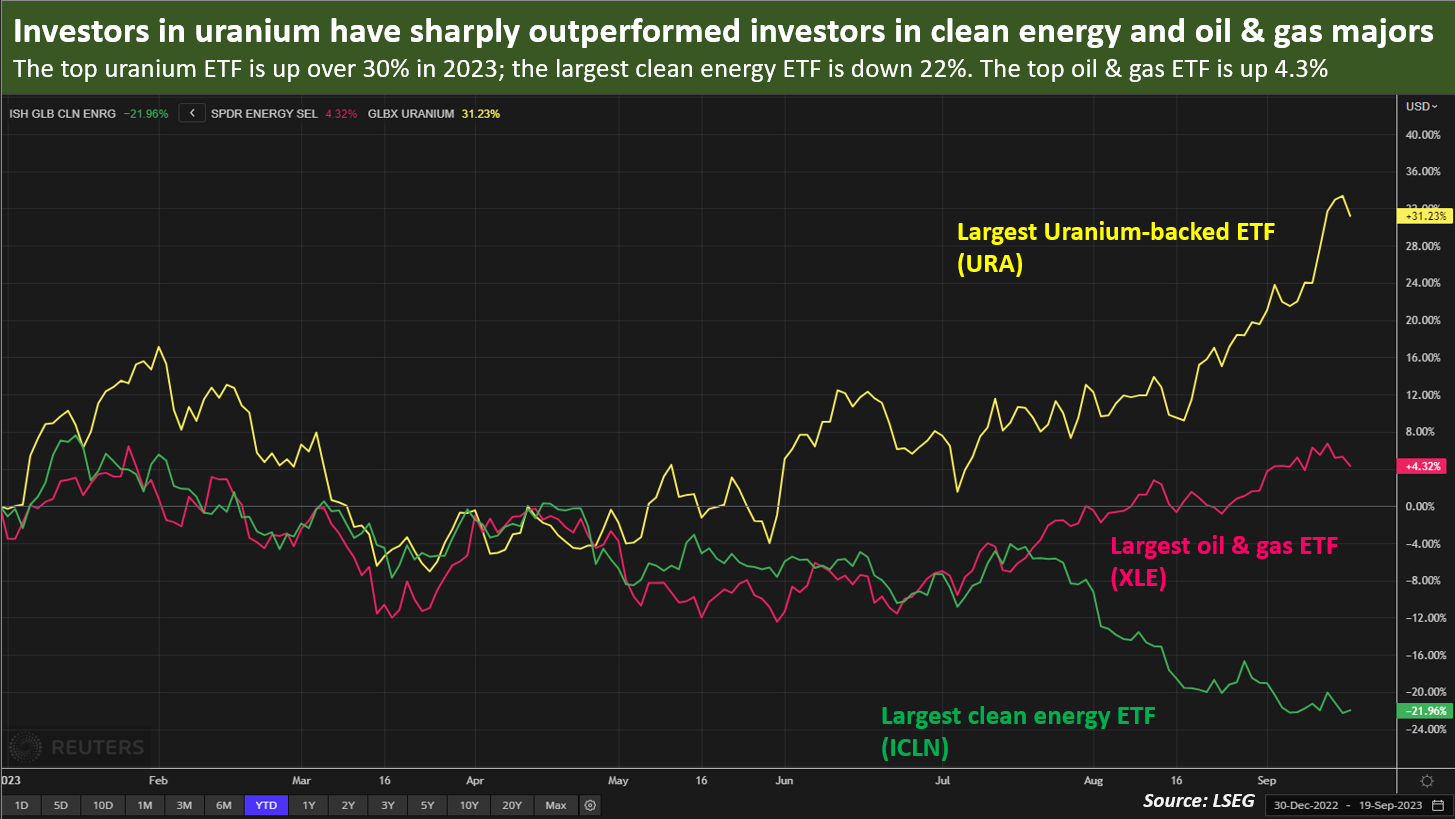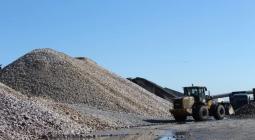Hyped up uranium investors face political fallout risk

LITTLETON, Colorado, Sept 21 (Reuters) - Uranium investors are on a roll, with several prominent uranium-based investment vehicles gaining over 30% already in 2023, and are confident that tight supplies and strong demand will keep the positive momentum going.
But even with global uranium consumption set to consistently outstrip supply over the coming years, investors still risk market setbacks tied to the decisions of governments which ultimately have the most decisive say over the long-term outlook for the power source.
SUPPORT SHIFT
Fuelling uranium's gains has been a palpable shift in support for nuclear power among a range of influential bodies who champion nuclear power's ability to displace high-polluting fossil fuels in electricity generation.
A key stance reversal on nuclear power came from Finland's Green Party, which for decades had been a fierce opponent of nuclear power but in 2022 voted overwhelmingly to rewrite its party manifesto and categorise nuclear power as a form of sustainable energy.

The significance of that change extends well beyond Finland's power market, which gets over a third of its electricity from nuclear plants.
As the first Green Party to adopt the stance, it provided licence for other Green political groups to follow suit.
In addition, the manifesto overhaul appeared to capture a widely held view that, given the urgent need to cut global emissions, nuclear power could quickly help attain aggressive decarbonisation goals by scaling up output and replace power from dirtier plants.
RIDING THE WAVE
Beyond the Finland Green Party reversal, other political U-turns on nuclear power have materialised, including in Spain, Belgium and, most recently, in Sweden, where a government energy target was reworded from "100% renewable" to "100% fossil-free" to allow for greater use of nuclear power.
Even in Germany, which just shuttered its last remaining nuclear plants earlier this year, there have been calls from within the ruling coalition government to stop the dismantling of old plants in case they are needed in future.
All of these announcements in support of nuclear have fostered upbeat sentiment in the market for uranium, which remains the main fuel used in nuclear reactors.
Offering further support to uranium bulls is the tight supply side of the uranium market, with global production in 2022 roughly 18% lower than it was in 2017 due to relatively low uranium prices sparking declines in mining activity, according to the World Nuclear Association (WNA).
Market bulls are also upbeat about the fact that there is a shortage of production stemming from reliably Western-friendly nations, as more than 60% of world output comes from Kazakhstan, Uzbekistan, Russia, Niger and China, WNA data shows.
PRICE GAINS AND GROWING PAINS
In response to the double whammy of growing support for nuclear power and enduring tightness in uranium supplies, the price of uranium and the stocks of firms engaged in its mining and processing have charged higher.
The Global X Uranium ETF , the world's largest ETF exposed to the uranium space, is up 31% year-to-date, while Canada's first uranium ETF, the Horizons Global Uranium Index ETF (HURA.TO), is up over 45%, LSEG data shows.
Spot prices of the physical commodity are up by roughly a third this year, while uranium futures listed on the CME are up 35% year to date.
Many investors and industry analysts argue that the uranium rally has further to run, as prices must go high enough to spur the increases in output needed to fulfil the anticipated increases in demand from nuclear plants.
However, even with the broad new backing for nuclear, it is far from certain that a significant increase in nuclear power output will actually materialise.
A vast majority of nuclear power plants in Europe and the United States are already over 30 years old and at or beyond their planned lifetimes, which is fuelling safety concerns among engineers about extending operations, and outright push-back against increasing output levels.
In addition, the cost of building new nuclear plants has sky-rocketed in recent years. A new 3,200 megawatt (MW) plant planned in southwest England by France's EDF , the world's largest nuclear operator, is likely to cost roughly $40 billion, or 30% more than initial estimates, EDF documents show.
Even small-scale plants have risen dramatically in cost.
A planned 462-MW plant under construction by U.S. firm NuScale Power has seen cost estimates increase from $58 per megawatt hour in 2021 to $89/MWh in 2023, due to rises in construction and materials costs.
These increases equate to an extra $4 billion for the project, according to the Institute for Energy Economics & Financial Analysis.
Governments committed to energy system overhauls are fully prepared to pay billions of dollars to make it happen, so high price tags alone are not enough to prevent further nuclear plant development.
But many key power authorities are already on the hook for hefty expansions in renewable energy capacity, which can be brought online within a fraction of the decade-plus timelines normally associated with nuclear power plants.
That means that the only entities with deep enough pockets to afford new nuclear plants may opt instead for expanding renewable power supplies, and may rain on the uranium bull's parade far sooner than expected.
The opinions expressed here are those of the author, a columnist for Reuters.
Reporting By Gavin Maguire; Editing by Sonali Paul
File Photo: REUTERS/Mariana Bazo - Uranium stone is seen at a news conference of Macusani Yellowcake and Plateau Energy in Lima, Peru July 16, 2018.





